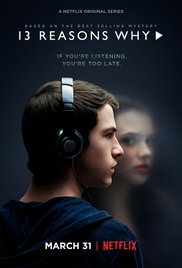 Reasons to Engage “13 Reasons Why”
Reasons to Engage “13 Reasons Why”
by Dr. Bill Clark
Over the next 6 weeks, we’re posting a series of blogs discussing the Netflix series, 13 Reasons Why, based on the 2007 book.
If you haven’t heard about it yet, the show 13 Reasons Why depicts the trials of a teen named Hannah, who decides to end her life after episodes of bullying, voyeurism, rejection, betrayal and sexual assault (as both a witness and victim). The viewer cannot help but see and feel the cumulative diet of shame and injury wear her down and deplete her resolve. In a bizarre (and unlikely until now[1]) act of care, vengeance, explanation, and/or confession, she leaves tapes targeting the 13 relationships/events that led to her decision.
My Concern
I first took notice because school systems sent statements home to parents warning them about the show, a rare occurrence. Then two of the McLean Presbyterian Church fellows watched and shared their reactions. They warned and encouraged me, especially as a counselor, to watch it (at my own risk). The effect it had on them, 23-year-old females, got to me. They couldn’t stop watching; it was compelling, disturbing, invasive (the scenes of rape and suicide are hard to erase), thought provoking and somehow, important. And millions of kids are watching it. In fact, some sources say that the show “racked up over 3.5 million social volume impressions in the first week of its release” (Source). And unfortunately, multiple parents are blaming the show for their own childrens’ recent suicide.
Millions of kids are watching it.
I then had parents begin to bring it up in counseling. They were discovering their kids had watched it and didn’t know what to do — especially when kids were lying or minimizing the effects. Other counselors were saying the same thing. I thought it critical to understand what was being provoked, what was causing such alarm and concern.[2]
I’ve watched almost all of the episodes and the post-show episode, taking notes. I’ve also read many (mixed) reviews from parents, counselors, kids, and adults involved in schools.
This is essentially my review, not so much of the series, but of some themes the show presents/exposes. It is also my attempt to make this a vehicle for meaningful dialogue and more involvement.
Three Recommendations
First, a few recommendations based on my experience and research:
- Watch the first episode (Tape 1) to meet the characters and get a feel for the show.
- Then watch the epilogue where the author, actors, producers and mental health consultants discuss the themes and what they were/are hoping to produce. You may feel a bit lost, but it will help prepare you and give you a reason for carrying on.
- Then watch a few more episodes to get a feel for the themes. If you are willing, watch it all before watching it with your kids. If you do this, you can pick what episodes or portions seem appropriate or useful to you.
Three Categories for Parents
Parents will fall in one of three categories:
- Your kids have seen it
- Your kids want to see it
- Your kids haven’t seen it (and you may have the ‘power’ to say no to them).
If you are in the first or second category, you should watch some— don’t miss this opportunity. If you’re in the third, you have more of a choice; it’s up to you if you are willing to be provoked. I do think you can watch portions of the episodes and get almost all of the benefit from the show (skip or fast-forward through the graphic scenes).
Just to be clear, I’m not a fan of kids watching this, especially if they are young, emotionally immature or unstable, insecure, prone to dark thoughts, and unable or unwilling to talk about its effects. I think it unwise for any teen to watch this alone.[3] Watching it with a kid who is struggling might help them verbalize their own plight, but that is a judgment call. I appreciate what the creators believed was helpful about showing the assaults and suicide (especially) in such graphic detail, but I wish they hadn’t[4]. It will help some kids and grossly mislead others. My greatest chagrin is that no viable alternative to Hannah’s choice was ever presented.
My greatest chagrin is that no viable alternative to Hannah’s choice was ever presented.
The blogs series that follow will present several “reasons” why adults involved with kids should watch at least some of this show, and some suggestions for how to use it. As troubling as the show is, I am grateful for it; it raises a call to action and opens a door to greater involvement with those who need it.
Join the conversation on 13 Reasons Why by following LCI on Facebook, or signing up to receive LCI emails.
Notes:
[1] Unfortunately, kids are now copying this pattern…
[2] The National Association of School Psychologists sent a notice to school mental health professionals across the country on how to talk about the show. A spokeswoman said it was the first time the association has put out guidance in response to a television show.
[3] I suspect this is all wishful thinking; most kids are too vulnerable, and most will watch it alone or with peers.
[4] I also wish God hadn’t been so graphic in the Bible. It raises the question, “When might my reaction be somewhat self-protective?”

